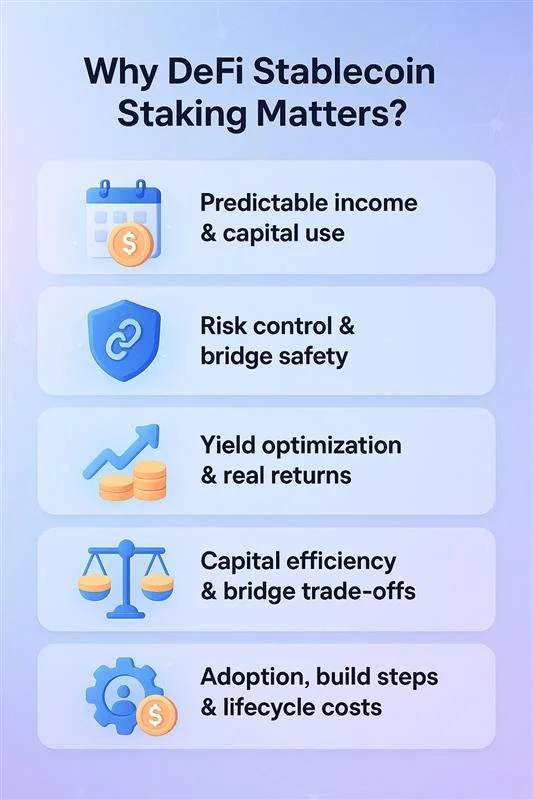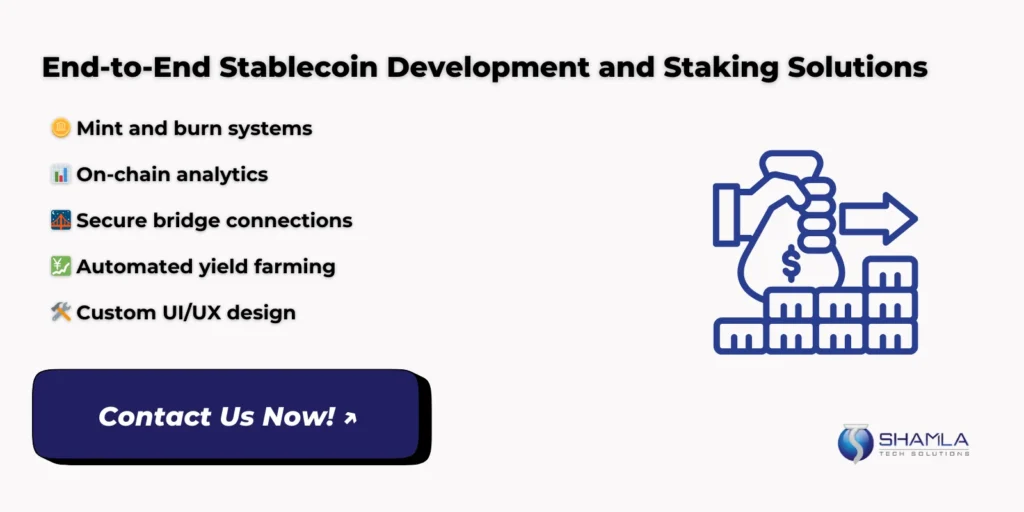DeFi stablecoin staking lets you lock stablecoins in smart contracts to earn steady income. Investors pick stable assets to avoid price swings while protocols pay staking rewards as interest, fees, or token bonuses. Choose platforms with clear on-chain rules, audited code, and visible APYs to lower risk.
Compare the best DeFi platforms for passive income by checking security history, liquidity depth, gas costs, and withdrawal terms. Begin with small stakes, monitor on-chain flows, and split funds across pools to reduce loss. This guide explains reward types, platform checks, and simple steps to start staking. Follow safety checks before every stake.
What is DeFi Stablecoin Staking and Why It Matters?
Why DeFi Stablecoin Staking Matters?

1. Predictable income and capital use
2. Risk control and bridge safety
3. Yield optimization and real returns
4. Capital efficiency and bridge trade-offs
5. Adoption, build steps and lifecycle costs
Best Strategies for DeFi Stablecoin Staking
1. Smart pool selection
Pick stable pools with clear fee splits and big liquidity. Stake to earn staking rewards while keeping the value steady. Run a small test stake to confirm real APY after fees and gas. Track pool share moves, withdrawal delays, and fee flow on-chain before you allocate more capital. Mix stablecoin yield farming across several pools to cut single pool risk.
Check oracle feeds, slippage limits, and keeper incentives. Prefer pools with long DeFi yield farming history and steady TVL. Avoid vaults with hidden leverage or opaque fees. Stop and withdraw if you see sudden admin changes or a fast TVL drop to protect capital. Record each trade in a simple sheet and review outcomes weekly.
2. Automation with guardrails
Use automation to move capital where net return is highest after fees and gas. Add automated yield optimization tools that redeploy funds into top pools and remove funds from weak ones. Set hard caps and pause rules to limit redeploy size and slow loops. Link read-only dashboards to watch TVL, APY, and withdrawal depth across chains.
Use stablecoin yield farming on trusted curves and stable swap pools to avoid slippage. Keep manual exit plans in case of a peg hit or bridge failure. Test automation with small runs and log real net return from DeFi yield farming before scaling. Audit automation rules, run scenario drills to check for failure and recovery paths.
3. Hedge, borrow, repay discipline
Use hedges and short borrows to widen returns while keeping risk low. Stake core stablecoins to capture staking rewards and borrow small amounts to test paths and borrow stablecoins for quick trades. Keep borrow size low and monitor the collateral ratio constantly. Use stablecoin lending for short loans and repay fast to avoid high interest and maintenance fees.
Watch oracle lag and loan rules to prevent surprise liquidations. Run liquidation drills in a test wallet and practice topping collateral quickly. Keep cash ready to top positions and use simple stop rules to avoid forced sells that wipe profits. Prefer fixed-rate windows when available and compare net carry across platforms.
4. Vaults, audits, and limits
Stack vaults only when you fully know each step in the strategy. Let automated yield optimization move idle cash into low slippage pools or short-term farms that match fee and gas profiles. Read the strategy code where possible and confirm fee splits, keeper pay, and exit steps. Use stablecoin yield farming plans that cap pool weight and avoid exotic peg mechanics.
Run on-chain checks for upgrade keys and see who can change strategy or pause withdrawals. DeFi yield farming looks better when fee and gas are low, so do short mainnet tests before scaling. Confirm multisig and timelock before commit now.
5. Fast rotation, measured moves
Chase spread with fast rotation and clear rules instead of risky leverage. Track price gaps and move funds fast between pools to capture staking rewards differences. Use stablecoin yield farming on high depth pairs to cut slippage and speed exits. Pair staking with stablecoin lending when the spread between lending and staking exceeds fees, and borrow stablecoins only for precise trades with clear exit plans.
Use automated yield optimization to shift capital to winning pools but set caps to stop loop risk. Keep transparent logs and simple sheets to calculate net gains after fees. Compare manual moves to tools, track net gain versus DeFi yield farming.
6. Build, buy, or outsource safely
Decide to build or buy based on scale and team skill. Use white label stablecoin services to launch user fronts fast, or hire stablecoin developers to code mint, burn, oracle, test flows. Make staking rewards and staking rewards logs visible on-chain so users see real APY and net fee split. Add automated yield optimization that moves idle cash into top pools, run a second automated yield optimization pass to avoid loop risk.
Combine DeFi yield farming templates with stablecoin yield farming on deep curves to diversify returns. Offer stablecoin lending access and let users borrow stablecoins for short trades with clear exit plans. Outsource audits and lock upgrade keys under multisig timelock to reduce risk. Track net return and user flows.
Emerging Use Cases and Future Trends in Stablecoin Staking
Play-to-earn and in-game cash flow
Web3 games need money that keeps value stable so players can buy and sell without big swings. Using stablecoin in Web3 Gaming lets developers pay rewards, run in-game markets, and hold escrow for item trades. Game teams link stable tokens to on-chain systems so items, payouts, and staking work without price shocks.
For players, DeFi stablecoin staking inside game hubs gives steady returns and helps fund prize pools and tournaments. Teams make this safe with clear mint rules, fast settlement, audited contracts, and simple withdrawal steps. They also test liquidity, bridge risk, and slippage before wide rollouts so players trust the system and activity grows. Game wallets should use multisig and timelock to limit admin risk and preserve player funds.
Cross-chain rails and liquidity depth
Cross-chain moves let stablecoins flow between blockchains so pools stay deep and swaps stay cheap. A cross-chain stablecoin bridges liquidity to new chains and helps games and markets expand to other networks. When teams use bridges, they must check relayer safety, exit delays, oracle sync, and slippage. Studios prefer chains with low gas and quick finality to keep trades fast.
Using stablecoin in Web3 Gaming across chains can bring global users and cut local currency friction. Teams should run small transfers, audit bridge contracts, and keep hot funds low. Prefer bridges with proof of reserve, multisig guardian, and on-chain dispute logs for safety. Market tools now show cross-chain TVL and fees to pick lanes with real depth.
Build rules, audits, and tooling for issuance
Teams that build stable tokens need clear rules for mint, burn, reserve audits, and oracle feeds. A good stablecoin development solutions stack includes on-chain contracts, multisig wallets, reserve audits, KYC plumbing, and simple dashboards. Development firms write code, run tests, and integrate price oracles so the peg stays tight.
Projects budget for audits, legal review, and insurance; these costs shape the cost of stablecoin development and time to launch. For DeFi stablecoin staking, teams must show proof of reserves and clear fee splits so stakers see real yield and real risk. Work with firms that publish code, run testnets, and use timelock upgrades. Keep public dashboards and event logs for simple transparency.
Regulation, Scale, and the Next Normal
Regulation and bank interest will push stablecoins into normal finance and open new uses for payments, treasuries, and tokenized cash. Firms will link token rails to payment rails, offer custody with compliance, and grow pool size. Automation will move more cash via automated yield optimization tools that chase net returns while cutting gas and fee drag.
New oracles, timelocks, and clearer reserve rules will lower upgrade risk and help audits. For users, DeFi stablecoin staking will become a standard option to park cash and earn yield while keeping value steady. Watch for more custodial partnerships, clearer reserve rules, and better cross-chain tooling that make moves faster and safer and push adoption into mainstream flows.
Conclusion
DeFi stablecoin staking turns idle stable dollars into steady earnings by locking tokens into vetted contracts that pay fees, interest, or protocol bonuses as staking rewards. Good practice: pick audited platforms, check on-chain flows, test small amounts, and track net yield after fees and gas before scaling positions.
Shamla Tech is a top stablecoin development company that builds stablecoins and DeFi stablecoin staking platforms that let users stake and earn. We design mint rules, set oracle feeds, run security audits, and deploy multisig controls so protocols stay simple and clear. Our team links lending and yield tools and shows real balances and earned returns daily.
Ready to launch your own stablecoin and staking platform?
Contact us today to design minting, audits, and clear staking interfaces fast!





